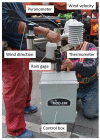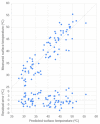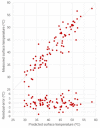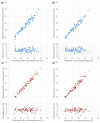Field Measurement of the Dynamic Interaction between Urban Surfaces and Microclimates in Humid Subtropical Climates with Multiple Sensors
- PMID: 38139681
- PMCID: PMC10747206
- DOI: 10.3390/s23249835
Field Measurement of the Dynamic Interaction between Urban Surfaces and Microclimates in Humid Subtropical Climates with Multiple Sensors
Abstract
Forcing pathways between urban surfaces (impervious and pervious pavers) and near-surface air temperature were measured and investigated with a network of multiple sensors. Utilizing field data measured between April 2021 and May 2022, and assuming that the influential variables follow the basic heat-transfer energy-balance equations, multiple regression-based statistical models were built to predict the surface temperature and near-surface air temperature (0.05 m, 0.5 m, 1 m, 2 m, and 3 m) of one impervious paver site and one pervious paver site in Taipei City, Taiwan. Evaporative cooling was found to be more influential on the pervious paver with a statistically significant influence on the microclimate up to 1.8 m (and up to 0.7 m for the impervious paver), using in situ data with an ambient air temperature higher than 24 °C. The surface temperature is mainly affected by solar shortwave radiation and ambient air temperature. As for near-surface air temperature, ambient air temperature is the most influential factor, followed by surface temperature. The importance of surface temperature indicates the influence of upwelling longwave radiation on the microclimate. The predictive equations show that pervious surfaces can help cities with hot and humid climates fight the changing climate in the future.
Keywords: field measurements; impervious; microclimate; multiple regression; permeable; pervious; urban heat island.
Conflict of interest statement
The authors declare no conflict of interest.
Figures









References
-
- Climate Change: Global Temperature. [(accessed on 31 May 2022)]; Available online: https://www.climate.gov/news-features/understanding-climate/climate-chan....
-
- Climate Change: Global Temperature Projections. [(accessed on 9 June 2022)]; Available online: https://www.climate.gov/news-features/understanding-climate/climate-chan....
-
- A Degree of Concern: Why Global Temperatures Matter. [(accessed on 9 June 2022)]; Available online: https://climate.nasa.gov/news/2878/a-degree-of-concern-why-global-temper...
-
- Sea Level to Rise up to a Foot by 2050, Interagency Report Finds. [(accessed on 9 June 2022)]; Available online: https://www.jpl.nasa.gov/news/sea-level-to-rise-up-to-a-foot-by-2050-int....
-
- Li D., Bou-zeid E. Synergistic Interactions between Urban Heat Islands and Heat Waves: The Impact in Cities Is Larger than the Sum of Its Parts. J. Appl. Meteorol. Climatol. 2013;52:2051–2064. doi: 10.1175/JAMC-D-13-02.1. - DOI
Grants and funding
LinkOut - more resources
Full Text Sources
Research Materials
Miscellaneous

